travis.taylor
Aluminum
- Joined
- Aug 5, 2011
- Location
- NE Texas
Hello All!!!
I'm just starting out in the machine trade (I'm still in votech, infact...) and I've been
trying hard to get together what I have come to consider the basics in precision tools.
Strangely enough, it seems like I'm the only one in my class to even consider purchasing
tools for some reason. Instead of spending $100 on cheap Chinese import tools, everyone
seems content on fighting over broken Chinese tools provided by the school...
Pure flabbergastation on my part I'll tell you what..
Anyways, after doing a lot of research on different tools from different brands and spending
pretty much any/all of my (very little) extra money on tools, I feel for some reason compelled
to share what I have gathered and my opinion on all of it...
I will say that I have a strong preference for manual machines vs. CNC.. CNC is just kind of
boring to me I guess. It seems like everyone simply wants something engraved. IDK...
P.s. I hope this isn't simply an annoyance to those on this forum. Definitely not my intention!!!
As you're about to see, I've developed quite the bias toward Starrett products. So there's your
Warning!!!
First up, a little something about compasses/dividers for drafting...
I first purchased a $10 compass from office depot. WRONG.
I then purchased a new $20 compass from Staedtler. Wrong again.
Both of these compasses were just about worthless due to the lack of quality. Very difficult to work with...
I decided to jump on ebay and look at "vintage" offerings and found this...

What a wonderful tool!!! It is a "Blue Dot" VEMCO compass probably manufactured in the ?'60s?
I ended up getting it plus the leadholder and 6" flexible rule by Lufkin for $12 and put it all in a Starrett
soft case. Probably the best money I've ever spent quality for dollar wise....
Next up, my "go-to" set, a student kit from Starrett. I forget the model #...

Here's what I've got to say about this set. I positively love it!! It's great having these items nicely organized
in a pretty little case while I'm at a machine or my table doing layout work. It makes me feel fuzzy inside
The calipers are the new version of the 120A (the plastic bezel). They are nice. Mitutoyo dial calipers are
quite a bit nicer. The 120A is great and perfectly accurate across its entire travel, but its got nothing on
a pair of Mitts when it comes to smooth travel and "feel"... The set originally included a "Yankee" style divider.
I gave them away after I paid $60 for a pair of Starrett's "Tool Maker's" dividers. Those are what the kit should
have come with originally IMO. The combo square, 6" flexible rule, and center punch? Easily the nicest I've ever seen
of ANY manufacturer of any time period. More on a full size combo square set in a bit!!
Now for a small assortment of Starrett paraphernalia...
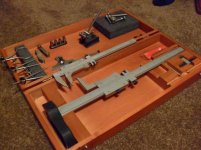
The first thing I'll comment on is set of small Tool Maker's style calipers/dividers. I bought these used and they seem
to be quite old. The fit and finish on these are quite superior to their newly manufactured versions.The pitch gages, depth
gage, surface gage, and toolmaker's buttons (apparently no longer made), are all VERY nice... I have a rather strange affinity
for the toolmaker's button for some reason. I just love the darn things and don't know why!! It must be something to
do with pre-CNC craftsmanship/magic... Hell, I don't know.. The edgefinder is pretty darn awesome. I chucked it up in a
nice Moore jig borer and edgefound (is that a word?) a cheap parallel a couple times and got awesome repeatability. Like,
.0000, .0000, .0001, .0000, .0002, etc... Maybe that's pretty average for an edgefinder, IDK.. But it took me by surprise.
The master verniers are quite simply the nicest, most beautifully made slide calipers I've ever held or seen, but with that
being said, I honestly cannot imagine paying $600 for them.. $250-$300? Any day. But $600? Ouch. I picked them up off ebay
for $150 and am VERY pleased. Kinda the same scenario with the height gage. EXTREMELY nice, but at $1200 new??
Maybe that's a realistic price point because of the awesome quality and CoO, but I would have expected the price to be
around $600-$800 new. I was VERY lucky to be able to pick it up BRAND NEW for $200
Now for a surprisingly controversial Starrett product, the LastWord Indicator..
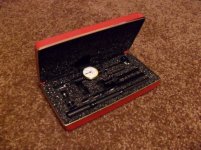
After some research, I was very skeptical about this purchase. There are quite a lot of negative opinions of the poor
little thing. But at that point, I had already become quite brand loyal and I found this kit for a reasonable price, so maybe
stupidly, I was willing to give it a shot. I'm glad I did. Are there better indicators? ABSOLUTLEY. Are there more versatile
indicators/kits? From my escapades with it and its attachments, I dare say no (I'm sure I'll get a rebuttal...).
From my short period of experience with it, I'd say that there are two major hang-ups for most people.
One, due to design, you MUST practice serious cleanliness with this indicator. I'm kind of a neat freak, so this doesn't
bother me. Two, you MUST have the travel lever set FULLY EXTREME IN ONE DIRECTION OR THE OTHER...
I got scared a couple of times by this when I thought my indicator was getting the infamous "sticky" condition.
Not the case. I've used this indicator with gage block setups and found any error in consistency of readings to be
perfectly indiscernible... I find the attachments and price point to be especially lovely!!
A Starrett trammel because of the sheet metal work I occasionally run into...
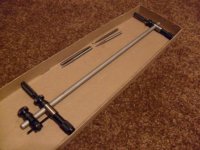
I'm sure a cheaper trammel will suffice almost anyone's needs, but darn is this thing nice. Worth every penny in my opinion.
I didn't get a case for it because it goes in my dedicated "layout" drawer...
I'm just starting out in the machine trade (I'm still in votech, infact...) and I've been
trying hard to get together what I have come to consider the basics in precision tools.
Strangely enough, it seems like I'm the only one in my class to even consider purchasing
tools for some reason. Instead of spending $100 on cheap Chinese import tools, everyone
seems content on fighting over broken Chinese tools provided by the school...
Pure flabbergastation on my part I'll tell you what..
Anyways, after doing a lot of research on different tools from different brands and spending
pretty much any/all of my (very little) extra money on tools, I feel for some reason compelled
to share what I have gathered and my opinion on all of it...
I will say that I have a strong preference for manual machines vs. CNC.. CNC is just kind of
boring to me I guess. It seems like everyone simply wants something engraved. IDK...
P.s. I hope this isn't simply an annoyance to those on this forum. Definitely not my intention!!!
As you're about to see, I've developed quite the bias toward Starrett products. So there's your
Warning!!!

First up, a little something about compasses/dividers for drafting...
I first purchased a $10 compass from office depot. WRONG.
I then purchased a new $20 compass from Staedtler. Wrong again.
Both of these compasses were just about worthless due to the lack of quality. Very difficult to work with...
I decided to jump on ebay and look at "vintage" offerings and found this...

What a wonderful tool!!! It is a "Blue Dot" VEMCO compass probably manufactured in the ?'60s?
I ended up getting it plus the leadholder and 6" flexible rule by Lufkin for $12 and put it all in a Starrett
soft case. Probably the best money I've ever spent quality for dollar wise....
Next up, my "go-to" set, a student kit from Starrett. I forget the model #...

Here's what I've got to say about this set. I positively love it!! It's great having these items nicely organized
in a pretty little case while I'm at a machine or my table doing layout work. It makes me feel fuzzy inside

The calipers are the new version of the 120A (the plastic bezel). They are nice. Mitutoyo dial calipers are
quite a bit nicer. The 120A is great and perfectly accurate across its entire travel, but its got nothing on
a pair of Mitts when it comes to smooth travel and "feel"... The set originally included a "Yankee" style divider.
I gave them away after I paid $60 for a pair of Starrett's "Tool Maker's" dividers. Those are what the kit should
have come with originally IMO. The combo square, 6" flexible rule, and center punch? Easily the nicest I've ever seen
of ANY manufacturer of any time period. More on a full size combo square set in a bit!!
Now for a small assortment of Starrett paraphernalia...

The first thing I'll comment on is set of small Tool Maker's style calipers/dividers. I bought these used and they seem
to be quite old. The fit and finish on these are quite superior to their newly manufactured versions.The pitch gages, depth
gage, surface gage, and toolmaker's buttons (apparently no longer made), are all VERY nice... I have a rather strange affinity
for the toolmaker's button for some reason. I just love the darn things and don't know why!! It must be something to
do with pre-CNC craftsmanship/magic... Hell, I don't know.. The edgefinder is pretty darn awesome. I chucked it up in a
nice Moore jig borer and edgefound (is that a word?) a cheap parallel a couple times and got awesome repeatability. Like,
.0000, .0000, .0001, .0000, .0002, etc... Maybe that's pretty average for an edgefinder, IDK.. But it took me by surprise.
The master verniers are quite simply the nicest, most beautifully made slide calipers I've ever held or seen, but with that
being said, I honestly cannot imagine paying $600 for them.. $250-$300? Any day. But $600? Ouch. I picked them up off ebay
for $150 and am VERY pleased. Kinda the same scenario with the height gage. EXTREMELY nice, but at $1200 new??
Maybe that's a realistic price point because of the awesome quality and CoO, but I would have expected the price to be
around $600-$800 new. I was VERY lucky to be able to pick it up BRAND NEW for $200

Now for a surprisingly controversial Starrett product, the LastWord Indicator..

After some research, I was very skeptical about this purchase. There are quite a lot of negative opinions of the poor
little thing. But at that point, I had already become quite brand loyal and I found this kit for a reasonable price, so maybe
stupidly, I was willing to give it a shot. I'm glad I did. Are there better indicators? ABSOLUTLEY. Are there more versatile
indicators/kits? From my escapades with it and its attachments, I dare say no (I'm sure I'll get a rebuttal...).
From my short period of experience with it, I'd say that there are two major hang-ups for most people.
One, due to design, you MUST practice serious cleanliness with this indicator. I'm kind of a neat freak, so this doesn't
bother me. Two, you MUST have the travel lever set FULLY EXTREME IN ONE DIRECTION OR THE OTHER...
I got scared a couple of times by this when I thought my indicator was getting the infamous "sticky" condition.
Not the case. I've used this indicator with gage block setups and found any error in consistency of readings to be
perfectly indiscernible... I find the attachments and price point to be especially lovely!!
A Starrett trammel because of the sheet metal work I occasionally run into...

I'm sure a cheaper trammel will suffice almost anyone's needs, but darn is this thing nice. Worth every penny in my opinion.
I didn't get a case for it because it goes in my dedicated "layout" drawer...



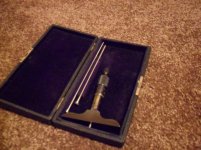





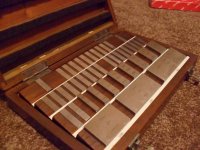
 Some blocks have small burrs, but most still wring
Some blocks have small burrs, but most still wring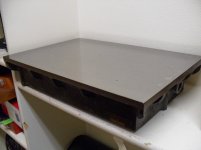


 , this advice from a calibration person and former Tool Room Coordinator.
, this advice from a calibration person and former Tool Room Coordinator. While this may not gaurentee acceptance, it at least offers a higher chance of acceptance.
While this may not gaurentee acceptance, it at least offers a higher chance of acceptance.
